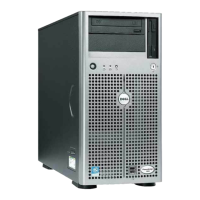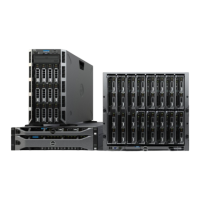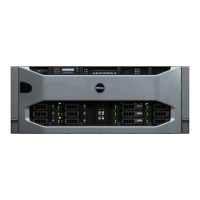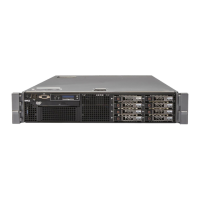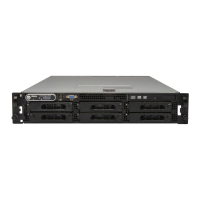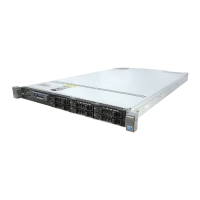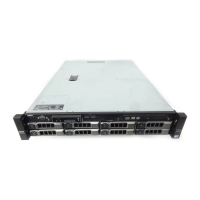Do you have a question about the Dell PowerEdge 1950 and is the answer not in the manual?
Details on additional documentation and resources for system setup and operation.
Information on keystrokes used to access system features during the boot process.
Description of controls, indicators, and connectors on the system's front panel.
Explanation of the indicator patterns for hard drive status and activity.
Description of controls, indicators, and connectors on the system's back panel.
Guidelines for connecting external devices to the system.
Information on power button and power supply indicator status.
Details on system status messages displayed on the control panel LCD.
Information on system messages, their causes, and corrective actions.
Procedure for accessing the System Setup program during system startup.
Overview of available configuration options within the System Setup program.
Details on CPU-related information accessible through System Setup.
Configuration options for integrated system devices like NICs and SATA controllers.
Settings for system and setup password protection and security features.
Explanation of system and setup password security features and their usage.
List of tools required for system component installation procedures.
Overview of the system's internal layout and components.
Steps for removing and reinstalling the system's front bezel.
Procedures for opening the system cover to access internal components.
Information about the system's cooling fan modules and their removal/replacement.
Details on system power supplies, installation, and removal.
Instructions for installing and removing SAS controller daughter cards.
Procedure for installing and removing the RAID controller battery.
Information on expansion card configurations and installation guidelines.
Guidelines for installing and configuring system memory modules.
Instructions for removing and installing system processors and heat sinks.
Procedure for installing and removing the Remote Access Controller (RAC) card.
Steps for removing and installing the system's optical drive tray.
Procedures for installing and removing SAS or SATA hard drives.
Instructions for removing and installing the SAS/SATA backplane board.
Steps for removing and installing the system's sideplane board.
Procedure for replacing the system's coin-cell battery.
Instructions for removing and installing the system's control panel assembly.
Procedures for removing and installing the system board.
Important safety precautions to follow when working with the system.
Guidance on observing system behavior during the startup process.
Procedures for checking system equipment and external devices.
Resolving conflicts related to Interrupt Request (IRQ) assignments.
Diagnosing issues related to loose or improperly connected external cables.
Steps to resolve problems with the system's video output and monitor.
Diagnosing and resolving issues with keyboard functionality.
Steps to identify and fix problems with the system mouse.
Resolving issues with basic input/output ports like serial ports.
Procedures for resolving problems with serial port connected devices.
Steps to diagnose and fix issues with USB devices and ports.
Resolving network communication problems with the Network Interface Card.
Actions to take if the system has been exposed to liquid or excessive humidity.
Steps to take if the system has been dropped or physically damaged.
Diagnosing and resolving issues related to the system's backup battery.
Steps to resolve problems indicated by power supply status indicators.
Addressing issues related to system cooling and fan errors.
Diagnosing and fixing problems related to system memory modules.
Resolving issues with the system's CD or DVD optical drive.
Steps to identify and fix hard drive errors or recognition problems.
Resolving issues with SAS or SAS RAID controller daughter cards.
Diagnosing and fixing problems with installed expansion cards.
Steps to resolve problems related to system processors.
Guide to using online Server Administrator diagnostics for system problem assessment.
Overview of the capabilities and options available in system diagnostics.
Criteria for utilizing system diagnostics to identify component failures.
Instructions on how to initiate and run system diagnostics tests.
Explanation of different testing options like Express, Extended, and Custom tests.
Details on customizing diagnostic tests by selecting specific devices and options.
Location and settings for configuration jumpers on the system board.
Procedure to disable or clear system and setup passwords using a jumper.
Description and location of connectors on the system board.
Details on connectors for SAS/SATA backplane boards supporting hard drives.
Information on expansion card riser components and PCI bus configurations.
Description of connectors located on the SAS sideplane board.
Steps to follow when seeking technical assistance for system problems.
Information on accessing Dell's online support resources and services.
Details on Dell's automated technical support service for recorded answers.
Information on checking the status of Dell product orders.
Information on contacting Dell's technical support for hardware assistance.
Information on Dell's training and certification programs.
Contact information for issues related to product orders.
How to obtain information about additional Dell products.
Procedure for returning items for warranty repair or credit.
Preparations and information to have ready before contacting Dell support.
List of websites and contact details for reaching Dell support globally.
| Processor Sockets | 2 |
|---|---|
| Chipset | Intel 5000X |
| Memory Slots | 8 DIMM slots |
| Network | Dual embedded Broadcom NetXtreme II 5708 Gigabit Ethernet |
| Form Factor | 1U Rack |
| Processor | Intel Xeon 5100, 5300 series |
| Memory | Up to 32GB DDR2 |
| Storage | SAS or SATA |
| Drive Bays | Two 3.5" SAS or SATA drives or Four 2.5" SAS or SATA drives |
| RAID Controller | PERC 5/i, PERC 6/i |
| Power Supply | 670W redundant power supply (optional) |
| Operating System Support | Microsoft Windows Server, Red Hat Linux, SUSE Linux |

